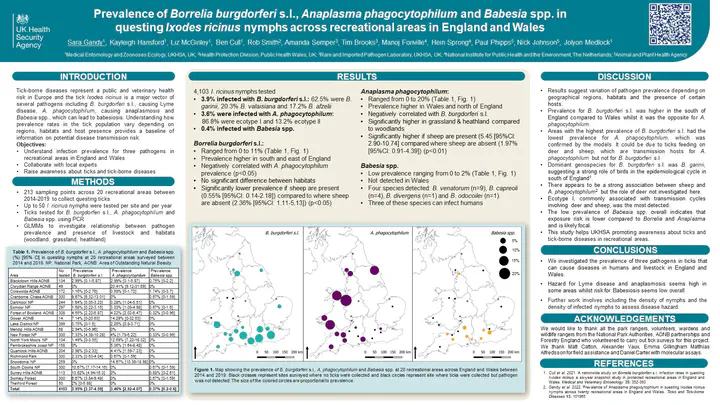Poster presentation at the 15th International Symposium on Ticks and Tick-borne Diseases in March 2023

Abstract
Understanding the variation in pathogens infections rates in Ixodes ricinus ticks is important for assessing potential transmission of tick-borne diseases. The aim if this study was to conduct a snapshot survey at recreational areas in England and Wales to understand infection prevalence for three tick borne transmitted pathogens. Ixodes ricinus nymphs were collected each spring at 20 recreational areas across England and Wales between 2014 and 2019. Questing nymphs were individually tested for presence of three pathogens; Borrelia burgdorferi s.l. (causing Lyme disease), Anaplasma phagocytophilum (causing anaplasmosis) and Babesia spp (causing babesiosis). Regarding B. burgdorferi s.l., 4104 nymphs were individually tested. Site-specific B. burgdorferi s.l. infection rates in I. ricinus nymphs varied from 0% to 9.7% depending on locations, with an average infection rate of 4.0%. Genospecies composition of sequenced samples was 62.5% B. garinii, 0.3% B. valaisiana and 17.2% B. afzelii. Anaplasma phagocytophilum was detected in 3.6% of questing nymphs (n=3919 tested), ranging from 0% to 20% depending on the location. Ecotype I accounted for 87% of positive samples and ecotype II for 13%. Babesia spp. was detected in 0.4% of ticks (n=3931). Ranging from 0% to 2.0%. Northern England and Wales had higher infection rates for A. phagocytophilum (4.7% and 12.1%) whilst B. burgdorferi s.l. infection rates were higher in southern (5.4%) and northern (2.3%) England. Borrelia burgdorferi s.l. infection rates were higher in woodland (5.6%) compared to grassland (2.6%) whilst more ticks were infected with A. phagocytophilum in grassland (6.7%) compared to woodland (0.6%). Infection rates for the three studied pathogens varied depending on geographical locations and this study increases the knowledge on the prevalence of causing agents of tick-borne diseases infection in recreational areas across England and Wales.